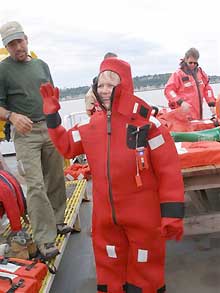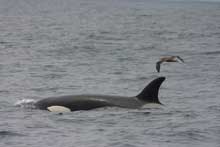About the Program

- Who May Apply
- Types of Cruises
- Time Committment
- Life at Sea
- Costs
Benefits for All
NOAA's Office of Marine and Aviation Operations
Overview
Since its inception in 1990, NOAA’s Teacher at Sea program has enabled more than 500 teachers to gain first-hand experience of science and life at sea. By participating in this program, it becomes possible for teachers to enrich their classroom curricula with a depth of understanding made possible by living and working side-by-side, day and night, with those who contribute to the world's body of oceanic and atmospheric scientific knowledge.
Details
Who May Apply
NOAA's Teacher at Sea program accepts applications from currently employed, full-time educators in these categories: K-12 teachers and administrators; community college, college, and university teachers; museum and aquaria educators; and adult education teachers. We accept applications from both American and international applicants, but our work with international appicants is always done through partnerships. We regret that we cannot accept applications from part-time, substitute, or pre-service teachers.
Types of Cruises
Teachers may select a cruise aboard one of NOAA's
19 ships. NOAA has three main types of vessels. Fisheries
research vessels perform biological and physical science studies
in support of fisheries research. Oceanographic and coastal
research vessels perform physical science studies in support of
physical oceanography, atmospheric studies, and bathymetric mapping. Hydrographic
survey vessels scan the coastal sea floor with side-scan sonar
and sophisticated bottom sounding systems to locate submerged obstructions
and navigational hazards for the creation or update of the nation's
nautical charts.

Time Commitment
Teachers can expect to be at sea anywhere from a week to a month. Most
teachers take advantage of cruises offered during the summer, but cruises take
place throughout the year.
Because of Homeland Security reasons, specific NOAA ship schedules are no longer made available to the public. Therefore, we ask applicants to list all the dates they will be available to sail so that we can then match paticipants' requests to a ship's schedule. The public may view NOAA's fleet allocation plan by going to http://www.omao.noaa.gov/shipallocation.html
Life at Sea
One aspect that NOAA’s Teacher at Sea program finds crucial to emphasize is that life at sea can be very unpredictable and flexibility and the ability to cope with the uncertain is crucial to the character of those who go to sea. Applicants should keep in mind the necessity for flexibility regarding ship departures and arrivals, ship working shifts, and the level of work intensity on some ships. As the unforeseen sometimes occurs, ship departure and arrival dates are never guaranteed. In fact, sailing can never be guaranteed. In addition, work shifts on some ships may be 4 hours on/4 hours off, 6 hours on/6 hours off, or 12 hours on/12 hours off. You may also be required to work a night shift. Finally, some cruises, especially fisheries cruises, require high-intensity work that demands physical adeptness and endurance.
Costs
All necessary travel costs are paid for by NOAA's Teacher at
Sea Program. While airfare is paid for up front by the
government, all other costs are reimbursed, including transportation costs, hotel costs, and per diem allowance.
(top)
Benefits for All
The benefits of NOAA's Teacher at Sea program are substantial for several stakeholders. To begin with, scientists, NOAA Corps officers, and crew gain motivated volunteers to help carry out their projects, and all onboard enjoy hosting someone who is enthusiastic and eager to learn about each aspect of the cruise.
Another crucial benefit offered by the Teacher at Sea program to NOAA and the nation is students' increased exposure to knowledge of marine careers. By talking about their experiences and sharing photos or video taken during a cruise, teachers can ecourage their students to consider potential marine careers with NOAA or other science-based organizations.
And perhaps most importantly, the program serves NOAA's mission by promoting among teachers and their students a greater awareness of the need to understand and protect the world's oceans and their resources.
The feedback from teachers who have participated in the program is overwhelmingly positive. Teachers underscore the fact that not only do they themselves benefit from what they learn on their cruises, but so do their students, communities, and the environment in general.
(top)
Indeed, these benefits may best be described by Melissa Fye, an elementary school teacher from Virginia: " I'm taking back to my classroom a wealth of resources like maps, charts, a binder of lessons, and many photographs and digital movies to weave into science lessons. But more importantly than those things, I will be bringing back to the classroom real-life enthusiasm for the application of science in the real world. I have experienced first-hand, biological ecosystems, weather instruments and measurements, and map making, in a real-liife context. I want my students to know that life is not a collection of things, but a collection of experiences. I hope this trip encourages them to explore opportunities as they arise in their own lives. As a teacher, my underlying goal is to teach my students that learning should be a life long adventure! And isn't that what this trip is really all about?"
NOAA's Office of Marine and Aviation Operations
The Teacher at Sea program is coordinated and administered by NOAA's Office of Marine and Aviation Operations (OMAO). OMAO operates, manages and maintains the NOAA fleet of ships and aircraft in support of NOAA's mission to understand and predict changes in the Earth's environment and conserve and manage coastal and marine resources to meet our nation's economic, social, and environmental needs. OMAO is composed of civilians, wage mariners, and the officers of the NOAA Commissioned Corps, one of the nation's seven uniformed services.
(top)
